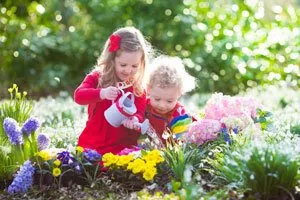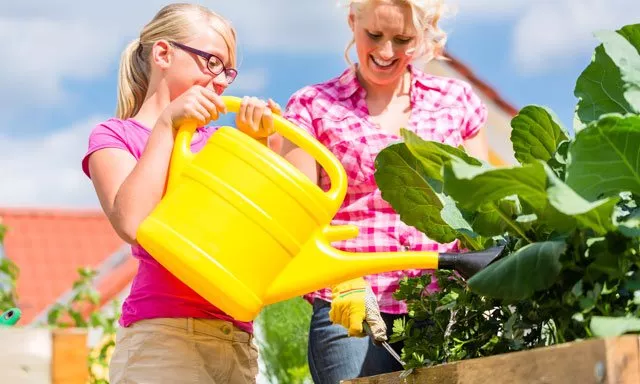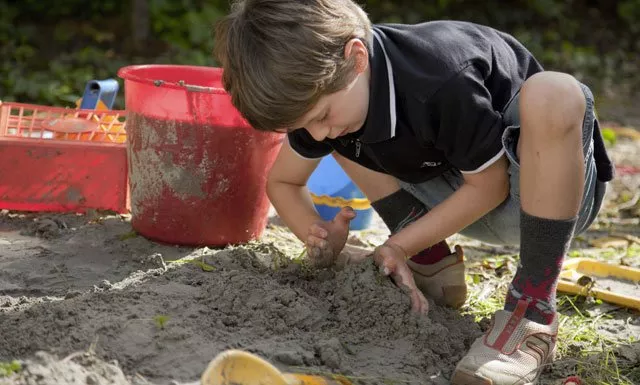Children love to play in the garden, but they also like to help at work. You can find out what you can expect of the little ones and tips for the play area here.
 It has already been mentioned several times in our various articles that a garden, if it is managed purely as a kitchen garden, can certainly be regarded as a source of self-sufficiency. For most garden owners, however, the little piece of green is a mixture of relaxation and work, the latter often being used to switch off from the actual job and the everyday stress that comes with it.
It has already been mentioned several times in our various articles that a garden, if it is managed purely as a kitchen garden, can certainly be regarded as a source of self-sufficiency. For most garden owners, however, the little piece of green is a mixture of relaxation and work, the latter often being used to switch off from the actual job and the everyday stress that comes with it.
Families usually have clear ideas of what the garden should look like, what should be planted where and in which corner the barbecue should be. Before you know it, every square meter is occupied and the little ones are neglected. Children like to be in the garden, especially so-called “city children”, who otherwise do not see much of nature. However, the ideas of offspring and parents do not always match. If you are redesigning your garden or making changes, you should definitely not forget the children when designing the garden. The following tips reveal what is feasible and how you can score points with the little ones.
Tip 1: Assign tasks to children
Gardening is not child labor! No way, the little ones, according to their age, are very happy to help. You just have to let them and prepare the garden a bit for it. The magazine elternwissen.com is even of the opinion that gardening promotes the child's senses, a theory that I can only agree with.
Jobs for the little ones
 Let even the little ones participate in what you do in the garden. For example, give them the task of scattering the seeds for radishes, parsley or even flowers. The adults prefer the rows and decide at what distance they should sow. You'll see, even three-year-olds will pick it up quickly and have fun with it.
Let even the little ones participate in what you do in the garden. For example, give them the task of scattering the seeds for radishes, parsley or even flowers. The adults prefer the rows and decide at what distance they should sow. You'll see, even three-year-olds will pick it up quickly and have fun with it.
Responsibility for the medium-sized ones
 It can be a bit more demanding for children aged 6 to 12. You can entrust your own piece of garden directly to them. Either you divide off a small area for this or you are thinking about purchasing oneraised beds after. No joke, the "miracle boxes" are now also available in child-friendly sizes and heights, for example at gfp-international.com, the garden and leisure professional. Having personal responsibility makes children proud and arouses the ambition that something will grow in “their” garden later.
It can be a bit more demanding for children aged 6 to 12. You can entrust your own piece of garden directly to them. Either you divide off a small area for this or you are thinking about purchasing oneraised beds after. No joke, the "miracle boxes" are now also available in child-friendly sizes and heights, for example at gfp-international.com, the garden and leisure professional. Having personal responsibility makes children proud and arouses the ambition that something will grow in “their” garden later.
Creating an incentive for the big ones
 Teenagers cannot be happy by pulling weeds or raking leaves. But you can quickly get enthusiastic about technical gimmicks. That's why boys are welcome to mow the lawn while the girls prune dry branches with pointed rose scissors. Of course, these tasks can also be distributed the other way around, gardening is not gender-dependent. ? In order to increase the incentive a little, a small fee can also be promised for longer-term tasks, such as painting the garden fence.
Teenagers cannot be happy by pulling weeds or raking leaves. But you can quickly get enthusiastic about technical gimmicks. That's why boys are welcome to mow the lawn while the girls prune dry branches with pointed rose scissors. Of course, these tasks can also be distributed the other way around, gardening is not gender-dependent. ? In order to increase the incentive a little, a small fee can also be promised for longer-term tasks, such as painting the garden fence.
Tip 2: create a small play paradise in the garden
Children are first and foremost children, which means they love to do one thing and that is playing. That's why there should always be a spot in the garden to let off steam. Depending on the space available, you will certainly have to make compromises here. But even in the smallest garden there is a way to create a space for the children.
Sandbox vs. Mud Pit
 I don't think I've ever seen a family garden without a sandbox. Somehow the Buddelkasten is one of the first purchases ever. This is by no means wrong and is particularly suitable for small children. For pre-school and older children you can offer something more, namely a mud pit. That may sound like a mess and a constantly running washing machine, but the kids will like it. They don't just wallow in the dirt, they let their imaginations run wild. This sometimes results in "ultramodern" sewer systems, from which valuable stones, earthworms and beetles are also brought to light.
I don't think I've ever seen a family garden without a sandbox. Somehow the Buddelkasten is one of the first purchases ever. This is by no means wrong and is particularly suitable for small children. For pre-school and older children you can offer something more, namely a mud pit. That may sound like a mess and a constantly running washing machine, but the kids will like it. They don't just wallow in the dirt, they let their imaginations run wild. This sometimes results in "ultramodern" sewer systems, from which valuable stones, earthworms and beetles are also brought to light.
The easiest swing in the world
 Swings, seesaws, climbing frames, all of this can now be purchased for a lot of money in the hardware store, but you can also save on it. If there are trees in your garden with trunks of adequate thickness, then these are the cornerstones for your personal children's swing.
Swings, seesaws, climbing frames, all of this can now be purchased for a lot of money in the hardware store, but you can also save on it. If there are trees in your garden with trunks of adequate thickness, then these are the cornerstones for your personal children's swing.
And while we're on the subject of play equipment made of natural materials: a tree trunk lying on the ground is a perfect one balancing pole. Various ropes hung in the trees are the alternative to the climbing frame. ?
For hot days:paddling pool or garden hose
 When the weather is nice, kill two birds with one stone: enjoy the sun on the terrace while your children splash around. Inflatable pools are almost thrown after you at the beginning of the season. The purchase, i.e. the size, should definitely correspond to the number of children and their age. When setting up in the garden, be sure to examine the soil. The ground must be as smooth as possible and free of small stones or sticks, otherwise holes will appear in the tarpaulin.
When the weather is nice, kill two birds with one stone: enjoy the sun on the terrace while your children splash around. Inflatable pools are almost thrown after you at the beginning of the season. The purchase, i.e. the size, should definitely correspond to the number of children and their age. When setting up in the garden, be sure to examine the soil. The ground must be as smooth as possible and free of small stones or sticks, otherwise holes will appear in the tarpaulin.
 What the swimming pool is for the little ones, the garden hose is for the grown-ups. This can easily be converted into a water spray machine. What is actually used for lawn irrigation can also be used as a playground equipment. Children love so-called sprinkler systems that are connected to a garden hose. Jumping around under it or trying to escape the water jet is so much fun for children, which is proven by numerous children's bright eyes. Place the system far enough away from the beds so that nothing is flooded, very few plants like waterlogging.
What the swimming pool is for the little ones, the garden hose is for the grown-ups. This can easily be converted into a water spray machine. What is actually used for lawn irrigation can also be used as a playground equipment. Children love so-called sprinkler systems that are connected to a garden hose. Jumping around under it or trying to escape the water jet is so much fun for children, which is proven by numerous children's bright eyes. Place the system far enough away from the beds so that nothing is flooded, very few plants like waterlogging.
If you don't want the little ones to get wet "from above", then water the lawn and then simply put children's rubber boots on them. Then your children can jump around in the puddles on the lawn. And if it rains a bit, a rain jacket, "mud pants" or rain pants (or rain pants for bikes) and a small umbrella will help.